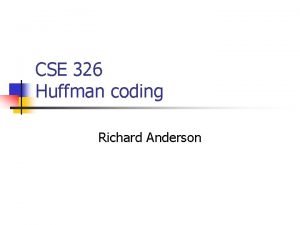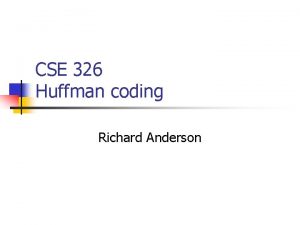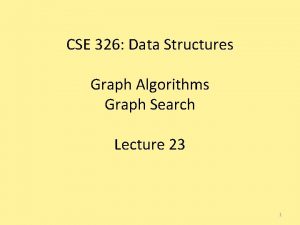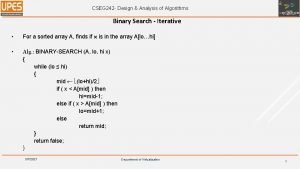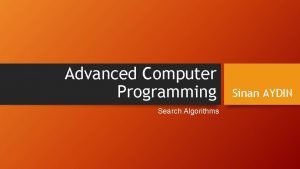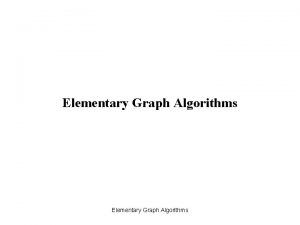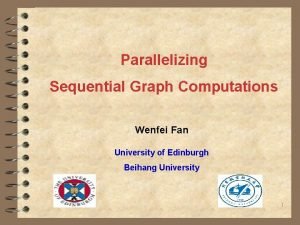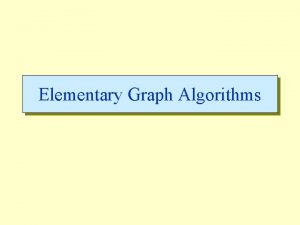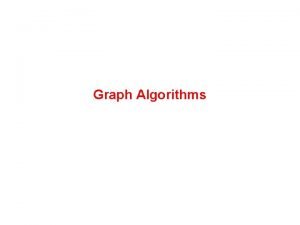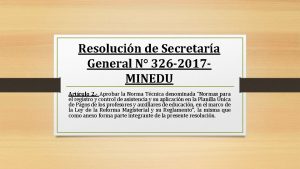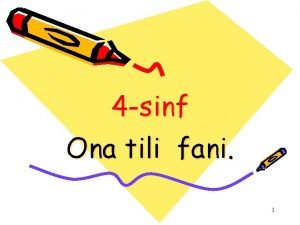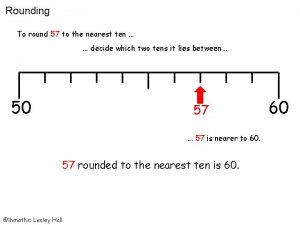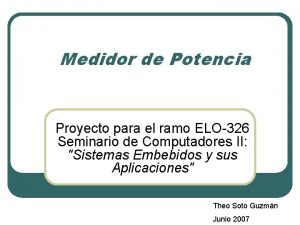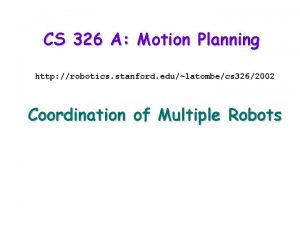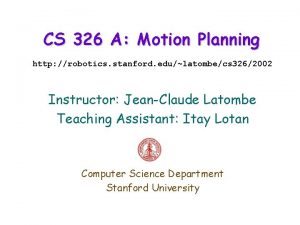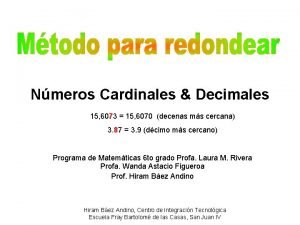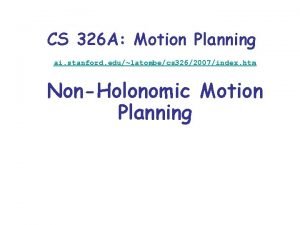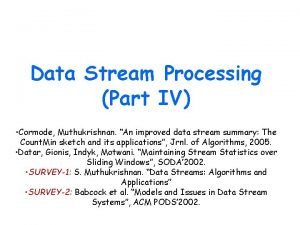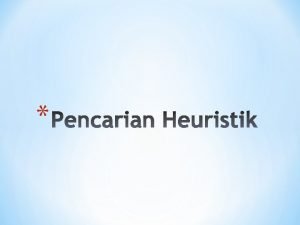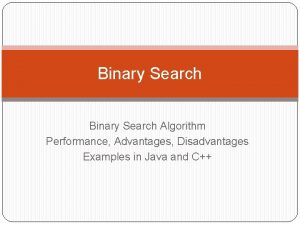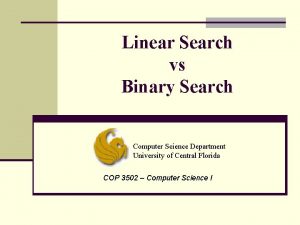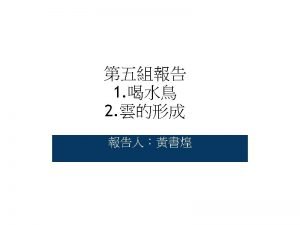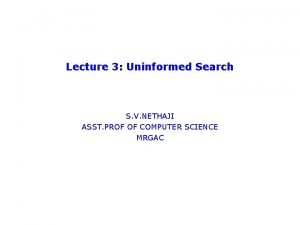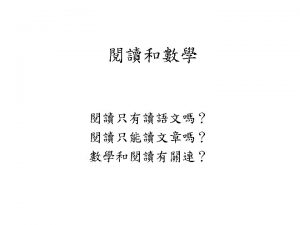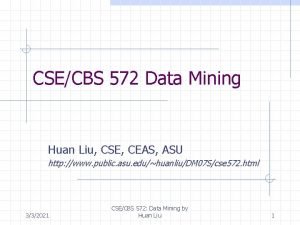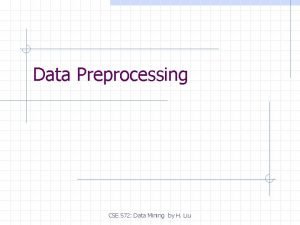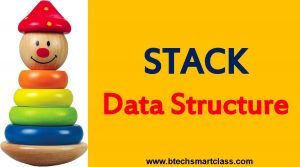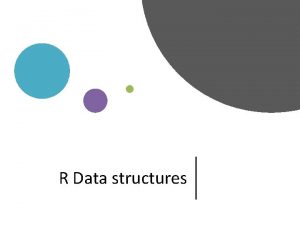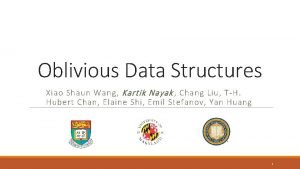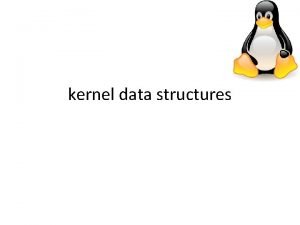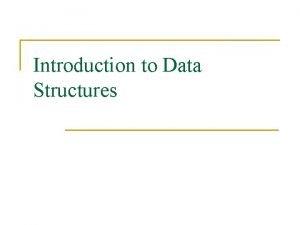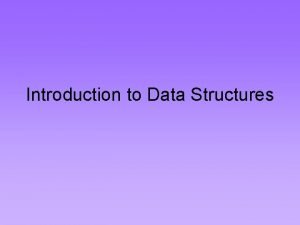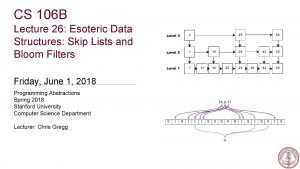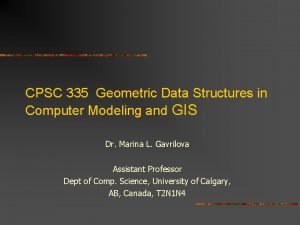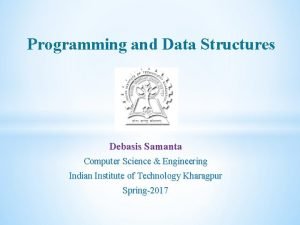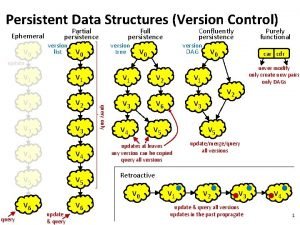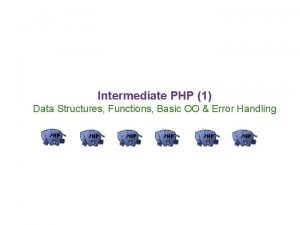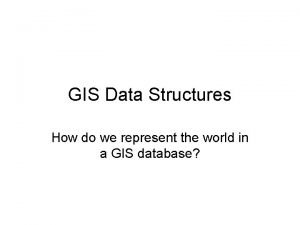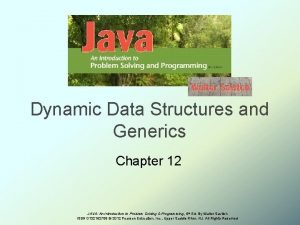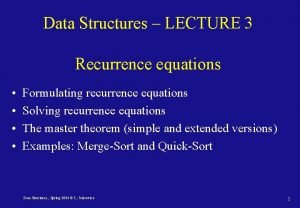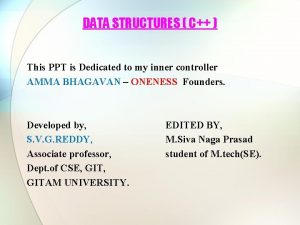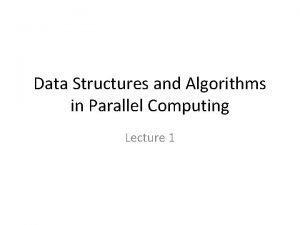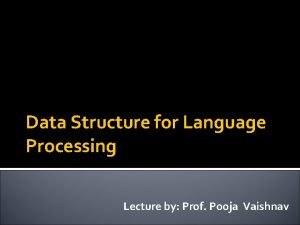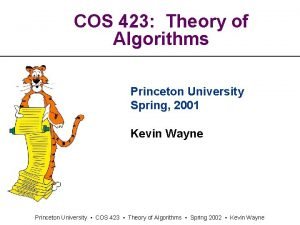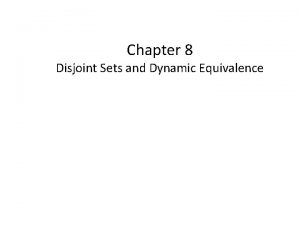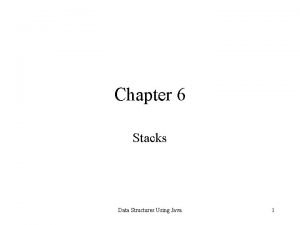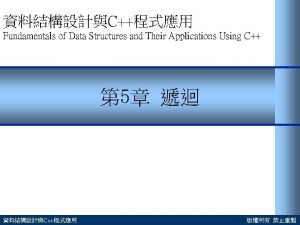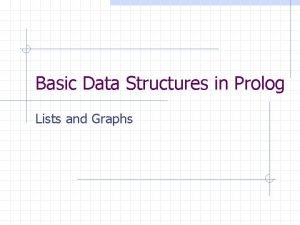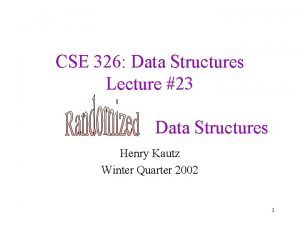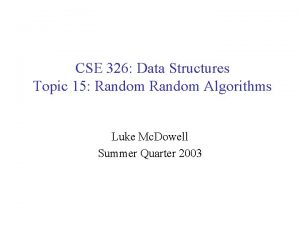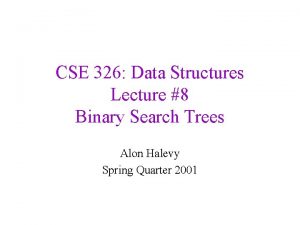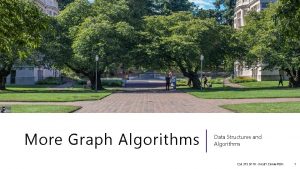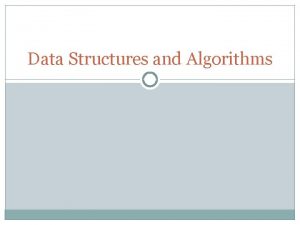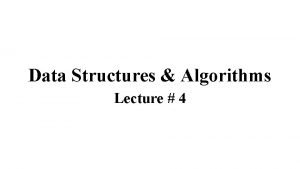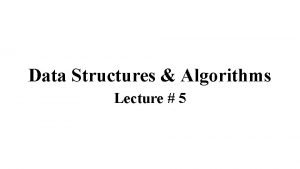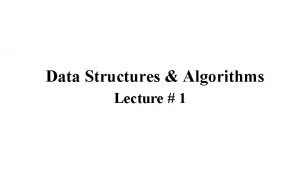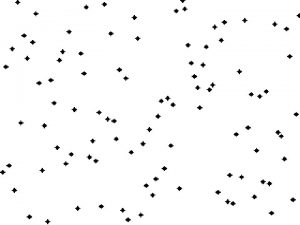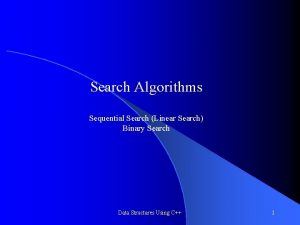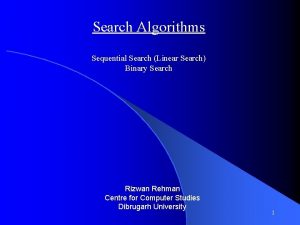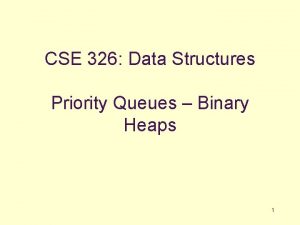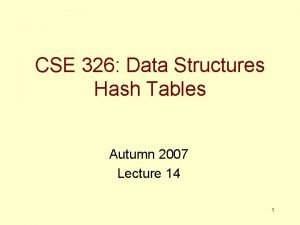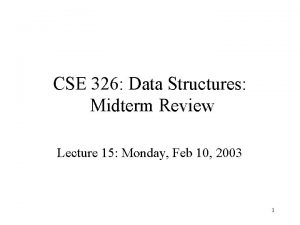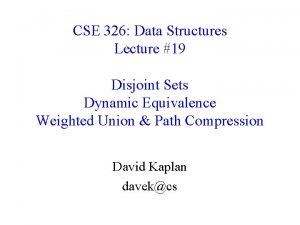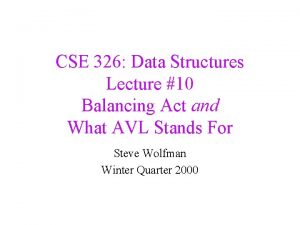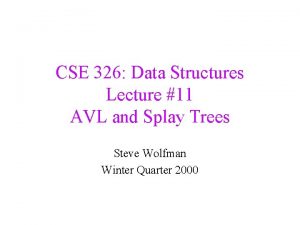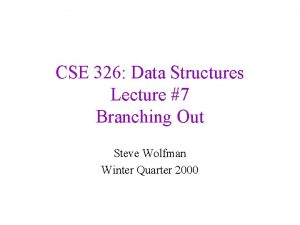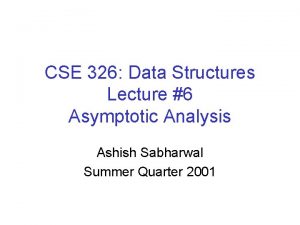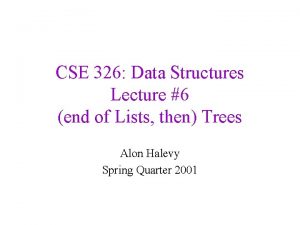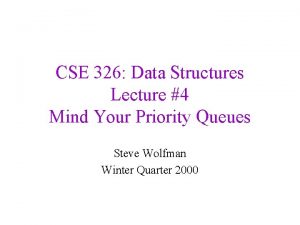CSE 326 Data Structures Graph Algorithms Graph Search




















































































- Slides: 84

CSE 326: Data Structures Graph Algorithms Graph Search Lecture 23 1

Problem: Large Graphs q It is expensive to find optimal paths in large graphs, using BFS or Dijkstra’s algorithm (for weighted graphs) q How can we search large graphs efficiently by using “commonsense” about which direction looks most promising? 2

Example 53 nd St 52 nd St G 51 st St S 50 th St 2 nd Ave 3 rd Ave 4 th Ave 5 th Ave 6 th Ave 7 th Ave 8 th Ave 9 th Ave 10 th Ave Plan a route from 9 th & 50 th to 3 rd & 51 st 3

Example 53 nd St 52 nd St G 51 st St S 50 th St 2 nd Ave 3 rd Ave 4 th Ave 5 th Ave 6 th Ave 7 th Ave 8 th Ave 9 th Ave 10 th Ave Plan a route from 9 th & 50 th to 3 rd & 51 st 4

Best-First Search • The Manhattan distance ( x+ y) is an estimate of the distance to the goal – It is a search heuristic q Best-First Search – Order nodes in priority to minimize estimated distance to the goal q Compare: BFS / Dijkstra – Order nodes in priority to minimize distance from the start 5

Best-First Search Open – Heap (priority queue) Criteria – Smallest key (highest priority) h(n) – heuristic estimate of distance from n to closest goal • Best_First_Search( Start, Goal_test) • insert(Start, h(Start), heap); • repeat • if (empty(heap)) then return fail; • Node : = delete. Min(heap); • if (Goal_test(Node)) then return Node; • for each Child of node do • if (Child not already visited) then • insert(Child, h(Child), heap); • end • Mark Node as visited; • end 6

Obstacles • Best-FS eventually will expand vertex to get back on the right track S 52 nd St G 51 st St 50 th St 2 nd Ave 3 rd Ave 4 th Ave 5 th Ave 6 th Ave 7 th Ave 8 th Ave 9 th Ave 10 th Ave 7

Non-Optimality of Best-First Path found by Best-first 53 nd St 52 nd St S 51 st St G 50 th St 2 nd Ave 3 rd Ave 4 th Ave 5 th Ave 6 th Ave 7 th Ave 8 th Ave 9 th Ave 10 th Ave Shortest Path 8

Improving Best-First q. Best-first is often tremendously faster than BFS/Dijkstra, but might stop with a non-optimal solution q. How can it be modified to be (almost) as fast, but guaranteed to find optimal solutions? q. A* - Hart, Nilsson, Raphael 1968 – One of the first significant algorithms developed in AI – Widely used in many applications 9

A* • Exactly like Best-first search, but using a different criteria for the priority queue: • minimize (distance from start) + (estimated distance to goal) • priority f(n) = g(n) + h(n) f(n) = priority of a node g(n) = true distance from start h(n) = heuristic distance to goal 10

Optimality of A* • Suppose the estimated distance is always less than or equal to the true distance to the goal – heuristic is a lower bound • Then: when the goal is removed from the priority queue, we are guaranteed to have found a shortest path! 11

A* in Action 2 nd Ave 3 rd Ave 4 th Ave 5 th Ave 6 th Ave 7 th Ave 8 th Ave 9 th Ave 10 th Ave H=1+7 G S 51 st St h=7+3 h=6+2 53 nd St 52 nd St 50 th St 12

Application of A*: Speech Recognition • (Simplified) Problem: – System hears a sequence of 3 words – It is unsure about what it heard • For each word, it has a set of possible “guesses” • E. g. : Word 1 is one of { “hi”, “high”, “I” } – What is the most likely sentence it heard? 13

Speech Recognition as Shortest Path • Convert to a shortest-path problem: – Utterance is a “layered” DAG – Begins with a special dummy “start” node – Next: A layer of nodes for each word position, one node for each word choice – Edges between every node in layer i to every node in layer i+1 • Cost of an edge is smaller if the pair of words frequently occur together in real speech – Technically: - log probability of co-occurrence – Finally: a dummy “end” node – Find shortest path from start to end node 14

W 1 1 W 1 2 W 2 1 W 1 3 W 2 2 W W 3111 W 3 3 W 4 1 W 4 3 15

Summary: Graph Search • Depth First – Little memory required – Might find non-optimal path • Breadth First – Much memory required – Always finds optimal path • Iterative Depth-First Search – Repeated depth-first searches, little memory required • Dijskstra’s Short Path Algorithm – Like BFS for weighted graphs • Best First – Can visit fewer nodes – Might find non-optimal path • A* – Can visit fewer nodes than BFS or Dijkstra – Optimal if heuristic estimate is a lower-bound 16

Dynamic Programming • Algorithmic technique that systematically records the answers to sub-problems in a table and re-uses those recorded results (rather than re-computing them). • Simple Example: Calculating the Nth Fibonacci number. Fib(N) = Fib(N-1) + Fib(N-2) 17

Floyd-Warshall • for (int k = 1; k =< V; k++) • for (int i = 1; i =< V; i++) • for (int j = 1; j =< V; j++) • if ( ( M[i][k]+ M[k][j] ) < M[i][j] ) M[i][j] = M[i][k]+ M[k][j] Invariant: After the kth iteration, the matrix includes the shortest paths for all pairs of vertices (i, j) containing only vertices 1. . k as intermediate vertices 18

2 a Initial state of the matrix: 1 -4 b b c d e a 0 2 - -4 - b - 0 -2 1 3 c - - 0 - 1 d - - - 0 4 e - - 0 c 3 d a -2 4 M[i][j] = min(M[i][j], M[i][k]+ M[k][j]) e 1 19

2 a Floyd-Warshall for All-pairs shortest path 1 -4 d 4 a b c d a 0 2 0 -4 0 b - 0 -2 1 -1 c - - 0 - 1 d - - - 0 4 e - - 0 b -2 c 3 e 1 e Final Matrix Contents 20

CSE 326: Data Structures Network Flow 21

Network Flows • Given a weighted, directed graph G=(V, E) • Treat the edge weights as capacities • How much can we flow through the graph? 1 A B 3 9 H 6 12 C 13 4 11 5 2 10 D 7 F 4 E G 11 20 6 I 22

Network flow: definitions • Define special source s and sink t vertices • Define a flow as a function on edges: – Capacity: – Conservation: f(v, w) <= c(v, w) for all u except source, sink – Value of a flow: – Saturated edge: when f(v, w) = c(v, w) 23

Network flow: definitions • Capacity: you can’t overload an edge • Conservation: Flow entering any vertex must equal flow leaving that vertex • We want to maximize the value of a flow, subject to the above constraints 24

Network Flows • Given a weighted, directed graph G=(V, E) • Treat the edge weights as capacities • How much can we flow through the graph? 1 s B 3 9 H 6 12 C 13 4 11 5 2 10 D 7 F 4 E G 11 20 6 t 25

A Good Idea that Doesn’t Work • Start flow at 0 • “While there’s room for more flow, push more flow across the network!” – While there’s some path from s to t, none of whose edges are saturated – Push more flow along the path until some edge is saturated – Called an “augmenting path” 26

How do we know there’s still room? • Construct a residual graph: – Same vertices – Edge weights are the “leftover” capacity on the edges – If there is a path s t at all, then there is still room 27

Example (1) Initial graph – no flow 2 B C 3 4 1 A D 2 4 2 2 E F Flow / Capacity 28

Example (2) Include the residual capacities 0/2 B 2 C 0/3 3 A 0/1 2 0/2 1 D 0/4 2 0/2 4 0/2 E Flow / Capacity Residual Capacity 4 0/4 2 F 29

Example (3) Augment along ABFD by 1 unit (which saturates BF) 0/2 B 2 C 1/3 2 A 1/1 2 0/2 0 D 1/4 2 0/2 3 0/2 E Flow / Capacity Residual Capacity 4 0/4 2 F 30

Example (4) Augment along ABEFD (which saturates BE and EF) 0/2 B 2 C 3/3 0 A 1/1 0 2/2 0 D 3/4 2 0/2 1 2/2 E Flow / Capacity Residual Capacity 4 0/4 0 F 31

Now what? • There’s more capacity in the network… • …but there’s no more augmenting paths 32

Network flow: definitions • Define special source s and sink t vertices • Define a flow as a function on edges: – Capacity: – Skew symmetry: – Conservation: f(v, w) <= c(v, w) f(v, w) = -f(w, v) for all u except source, sink – Value of a flow: – Saturated edge: when f(v, w) = c(v, w) 33

Network flow: definitions • Capacity: you can’t overload an edge • Skew symmetry: sending f from u v implies you’re “sending -f”, or you could “return f” from v u • Conservation: Flow entering any vertex must equal flow leaving that vertex • We want to maximize the value of a flow, subject to the above constraints 34

Main idea: Ford-Fulkerson method • Start flow at 0 • “While there’s room for more flow, push more flow across the network!” – While there’s some path from s to t, none of whose edges are saturated – Push more flow along the path until some edge is saturated – Called an “augmenting path” 35

How do we know there’s still room? • Construct a residual graph: – Same vertices – Edge weights are the “leftover” capacity on the edges – Add extra edges for backwards-capacity too! – If there is a path s t at all, then there is still room 36

Example (5) Add the backwards edges, to show we can “undo” some flow 0/2 3 B C 2 3/3 A 4 1 0 2/2 1/1 0 D 3/4 2 0/2 1 2/2 E Flow / Capacity Residual Capacity Backwards flow 0/4 0 F 3 2 37

Example (6) Augment along AEBCD (which saturates AE and EB, and empties BE) 2/2 3 B 3/3 0 A 2 C 0 2 1 2 2 0/2 1/1 0 D 3/4 0 2/2 1 E Flow / Capacity Residual Capacity Backwards flow 2/4 2/2 0 F 3 2 38

Example (7) Final, maximum flow 2/2 B C 2/4 3/3 1/1 A D 0/2 3/4 2/2 E Flow / Capacity Residual Capacity Backwards flow 2/2 F 39

How should we pick paths? • Two very good heuristics (Edmonds-Karp): – Pick the largest-capacity path available • Otherwise, you’ll just come back to it later…so may as well pick it up now – Pick the shortest augmenting path available • For a good example why… 40

Don’t Mess this One Up 0/2000 B 0/2000 0/1 A 0/2000 C D 0/2000 Augment along ABCD, then ACBD, then ABCD, then ACBD… Should just augment along ACD, and ABD, and be finished 41

Running time? • Each augmenting path can’t get shorter…and it can’t always stay the same length – So we have at most O(E) augmenting paths to compute for each possible length, and there are only O(V) possible lengths. – Each path takes O(E) time to compute • Total time = O(E 2 V) 42

Network Flows • What about multiple sources? 1 s B 3 9 H 6 12 C 13 4 11 5 2 10 s 7 F 4 E G 11 20 6 t 43

Network Flows • Create a single source, with infinite capacity edges connected to sources • Same idea for multiple sinks 1 s B 3 ∞ s! 9 ∞ H 6 12 C 13 4 11 5 2 10 s 7 F 4 E G 11 20 6 t 44

One more definition on flows • We can talk about the flow from a set of vertices to another set, instead of just from one vertex to another: – Should be clear that f(X, X) = 0 – So the only thing that counts is flow between the two sets 45

Network cuts • Intuitively, a cut separates a graph into two disconnected pieces • Formally, a cut is a pair of sets (S, T), such that and S and T are connected subgraphs of G 46

Minimum cuts • If we cut G into (S, T), where S contains the source s and T contains the sink t, • Of all the cuts (S, T) we could find, what is the smallest (max) flow f(S, T) we will find? 47

Min Cut - Example (8) T S 2 B C 3 4 1 A D 2 4 2 2 E Capacity of cut = 5 F 48

Coincidence? • NO! Max-flow always equals Min-cut • Why? – If there is a cut with capacity equal to the flow, then we have a maxflow: • We can’t have a flow that’s bigger than the capacity cutting the graph! So any cut puts a bound on the maxflow, and if we have an equality, then we must have a maximum flow. – If we have a maxflow, then there are no augmenting paths left • Or else we could augment the flow along that path, which would yield a higher total flow. – If there are no augmenting paths, we have a cut of capacity equal to the maxflow • Pick a cut (S, T) where S contains all vertices reachable in the residual graph from s, and T is everything else. Then every edge from S to T must be saturated (or else there would be a path in the residual graph). So c(S, T) = f(s, t) = |f| and we’re done. 49

Graph. Cut http: //www. cc. gatech. edu/cpl/projects/graphcuttextures/ 50

CSE 326: Data Structures Dictionaries for Data Compression 51

Dictionary Coding • Does not use statistical knowledge of data. • Encoder: As the input is processed develop a dictionary and transmit the index of strings found in the dictionary. • Decoder: As the code is processed reconstruct the dictionary to invert the process of encoding. • Examples: LZW, LZ 77, Sequitur, • Applications: Unix Compress, gzip, GIF 52

LZW Encoding Algorithm Repeat find the longest match w in the dictionary output the index of w put wa in the dictionary where a was the unmatched symbol 53

LZW Encoding Example (1) Dictionary ababa 0 a 1 b 54

LZW Encoding Example (2) Dictionary 0 a 1 b 2 ab ababa 0 55

LZW Encoding Example (3) Dictionary 0 1 2 3 a b ab ba ababa 01 56

LZW Encoding Example (4) Dictionary 0 1 2 3 4 a b ab ba ababa 01 2 57

LZW Encoding Example (5) Dictionary 0 1 2 3 4 5 a b ab ba ababa 01 2 4 58

LZW Encoding Example (6) Dictionary 0 1 2 3 4 5 a b ab ba ababa 01 2 4 3 59

LZW Decoding Algorithm • Emulate the encoder in building the dictionary. Decoder is slightly behind the encoder. initialize dictionary; decode first index to w; put w? in dictionary; repeat decode the first symbol s of the index; complete the previous dictionary entry with s; finish decoding the remainder of the index; put w? in the dictionary where w was just decoded; 60

LZW Decoding Example (1) Dictionary 0 a 1 b 2 a? 012436 a 61

LZW Decoding Example (2 a) Dictionary 0 a 1 b 2 ab 012436 a b 62

LZW Decoding Example (2 b) Dictionary 0 1 2 3 a b ab b? 012436 a b 63

LZW Decoding Example (3 a) Dictionary 0 1 2 3 a b ab ba 012436 a ba 64

LZW Decoding Example (3 b) Dictionary 0 1 2 3 4 a b ab ba ab? 012436 a b ab 65

LZW Decoding Example (4 a) Dictionary 0 1 2 3 4 a b ab ba aba 012436 a b ab a 66

LZW Decoding Example (4 b) Dictionary 0 1 2 3 4 5 a b ab ba aba? 012436 a b ab aba 67

LZW Decoding Example (5 a) Dictionary 0 1 2 3 4 5 a b ab ba abab 012436 a b ab aba b 68

LZW Decoding Example (5 b) Dictionary 0 1 2 3 4 5 6 a b ab ba abab ba? 012436 a b ab aba ba 69

LZW Decoding Example (6 a) Dictionary 0 1 2 3 4 5 6 a b ab ba abab 012436 a b ab aba ba b 70

LZW Decoding Example (6 b) Dictionary 0 1 2 3 4 5 6 7 a b ab ba abab bab? 012436 a b ab aba ba bab 71

Decoding Exercise Base Dictionary 0 1 2 3 4 0 1 4 0 2 0 3 5 7 a b c d r 72

Bounded Size Dictionary • Bounded Size Dictionary – n bits of index allows a dictionary of size 2 n – Doubtful that long entries in the dictionary will be useful. • Strategies when the dictionary reaches its limit. 1. 2. 3. 4. Don’t add more, just use what is there. Throw it away and start a new dictionary. Double the dictionary, adding one more bit to indices. Throw out the least recently visited entry to make room for the new entry. 73

Notes on LZW • Extremely effective when there are repeated patterns in the data that are widely spread. • Negative: Creates entries in the dictionary that may never be used. • Applications: – Unix compress, GIF, V. 42 bis modem standard 74

LZ 77 • • Ziv and Lempel, 1977 Dictionary is implicit Use the string coded so far as a dictionary. Given that x 1 x 2. . . xn has been coded we want to code xn+1 xn+2. . . xn+k for the largest k possible. 75

Solution A • If xn+1 xn+2. . . xn+k is a substring of x 1 x 2. . . xn then xn+1 xn+2. . . xn+k can be coded by <j, k> where j is the beginning of the match. • Example ababababab. . coded ababababab. . <2, 8> 76

Solution A Problem • What if there is no match at all in the dictionary? ababa cabababab. . coded • Solution B. Send tuples <j, k, x> where – If k = 0 then x is the unmatched symbol – If k > 0 then the match starts at j and is k long and the unmatched symbol is x. 77

Solution B • If xn+1 xn+2. . . xn+k is a substring of x 1 x 2. . . xn and xn+1 xn+2. . . xn+k+1 is not then xn+1 xn+2. . . xn+k+1 can be coded by <j, k, xn+k+1 > where j is the beginning of the match. • Examples ababa cabababab. . ababa c ababab. . <0, 0, c> <1, 9, b> 78

Solution B Example a babababababab. . . <0, 0, a> a b abababababab. . . <0, 0, b> a b aba bababababab. . . <1, 2, a> a b aba babababab. . . <2, 4, b> a b aba babababa bab. . . <1, 10, a> 79

Surprise Code! a babababababab$ <0, 0, a> a b abababababab$ <0, 0, b> a b abababababab$ <1, 22, $> 80

Surprise Decoding <0, 0, a><0, 0, b><1, 22, $> <0, 0, a> <0, 0, b> <1, 22, $> <2, 21, $> <3, 20, $> <4, 19, $>. . . <22, 1, $> <23, 0, $> a b a b b $ 81

Surprise Decoding <0, 0, a><0, 0, b><1, 22, $> <0, 0, a> <0, 0, b> <1, 22, $> <2, 21, $> <3, 20, $> <4, 19, $>. . . <22, 1, $> <23, 0, $> a b a b b $ 82

Solution C • The matching string can include part of itself! • If xn+1 xn+2. . . xn+k is a substring of x 1 x 2. . . xn xn+1 xn+2. . . xn+k that begins at j < n and xn+1 xn+2. . . xn+k+1 is not then xn+1 xn+2. . . xn+k+1 can be coded by <j, k, xn+k+1 > 83

Bounded Buffer – Sliding Window • We want the triples <j, k, x> to be of bounded size. To achieve this we use bounded buffers. – Search buffer of size s is the symbols xn-s+1. . . xn j is then the offset into the buffer. – Look-ahead buffer of size t is the symbols xn+1. . . xn+t • Match pointer can start in search buffer and go into the look-ahead buffer but no farther. match pointer uncoded text pointer Sliding window aaaabababaaab$ search buffer coded tuple <2, 5, a> look-ahead buffer uncoded 84
 Cse 326
Cse 326 Huffman coding
Huffman coding Cse 326
Cse 326 Professor ajit diwan
Professor ajit diwan Cos 423
Cos 423 Data structures and algorithms tutorial
Data structures and algorithms tutorial Information retrieval data structures and algorithms
Information retrieval data structures and algorithms Data structures and algorithms bits pilani
Data structures and algorithms bits pilani Ajit diwan iitb
Ajit diwan iitb Algorithms + data structures = programs
Algorithms + data structures = programs Data structures and algorithms
Data structures and algorithms Data structures and algorithms
Data structures and algorithms Waterloo data structures and algorithms
Waterloo data structures and algorithms Signature file structure in information retrieval system
Signature file structure in information retrieval system Data structures and algorithms
Data structures and algorithms Uninformed search methods
Uninformed search methods Search by image
Search by image Binary search in design and analysis of algorithms
Binary search in design and analysis of algorithms Advanced search algorithms
Advanced search algorithms Analogous structures
Analogous structures White path theorem
White path theorem Incrementalizing graph algorithms
Incrementalizing graph algorithms W graph
W graph Undirected graph algorithms
Undirected graph algorithms Rsg 326-2017-minedu
Rsg 326-2017-minedu Principezinho
Principezinho 4-b sinf
4-b sinf 71 to the nearest 10
71 to the nearest 10 C#
C# Ssis-326
Ssis-326 Cs 326 stanford
Cs 326 stanford Cs 326 stanford
Cs 326 stanford 326 ce
326 ce 326 ce
326 ce Como se escribe 1 decena de millar mas 3 centesimos
Como se escribe 1 decena de millar mas 3 centesimos Cs 326 stanford
Cs 326 stanford Lei 11 326
Lei 11 326 326 os kormányrendelet 2013
326 os kormányrendelet 2013 Ac 326
Ac 326 Data stream
Data stream Networks and graphs: circuits, paths, and graph structures
Networks and graphs: circuits, paths, and graph structures Unified search vs federated search
Unified search vs federated search Local search vs global search
Local search vs global search Federated search vs distributed search
Federated search vs distributed search Informed search and uninformed search in ai
Informed search and uninformed search in ai Images search yahoo
Images search yahoo Best first search
Best first search Heuristik
Heuristik Gravity yahoo
Gravity yahoo Yahoo
Yahoo Advantage and disadvantage of binary search tree
Advantage and disadvantage of binary search tree Search by image
Search by image Images.search.yahoo.com
Images.search.yahoo.com Semantic search vs cognitive search
Semantic search vs cognitive search Which search strategy is called as blind search
Which search strategy is called as blind search 1http
1http Cse 572 data mining
Cse 572 data mining Cse 572
Cse 572 Btechsmartclass c
Btechsmartclass c R data structures
R data structures Oblivious data structures
Oblivious data structures Kernel data structures
Kernel data structures Introduction to data structures
Introduction to data structures Introduction to data structures
Introduction to data structures Esoteric data structures
Esoteric data structures Geometric data structures
Geometric data structures Hadoop i/o
Hadoop i/o Define macro processor
Define macro processor Advanced data structures in java
Advanced data structures in java Assembler algorithm and data structures
Assembler algorithm and data structures Samantacomputer
Samantacomputer Persistent vs ephemeral data structures
Persistent vs ephemeral data structures Php data structures
Php data structures What is data structure in gis
What is data structure in gis Dynamic data structure in java
Dynamic data structure in java Recurrence data structures
Recurrence data structures Data structures in c ppt
Data structures in c ppt Data structures for parallel computing
Data structures for parallel computing Data structures and abstractions with java
Data structures and abstractions with java Data structures for language processing
Data structures for language processing Data structures princeton
Data structures princeton Dynamic equivalence problem in data structures
Dynamic equivalence problem in data structures Stacks in data structures
Stacks in data structures Fundamentals of data structures in c
Fundamentals of data structures in c Data structures in prolog
Data structures in prolog
